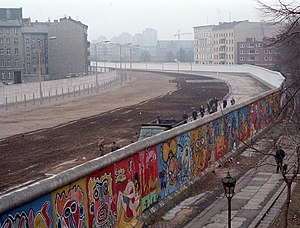Berlin Wall
From Wikipedia, the free encyclopedia
For the chess opening variation, see Berlin Defence.
View in 1986 from the west side of graffiti art on the wall's infamous "death strip"
Map of the location of the Berlin Wall, showingcheckpoints.
Satellite image of Berlin, with the wall's location marked in yellow
Occupation zone borders in Germany as of February 21, 1947. The territories east of the Oder-Neisse line, under Polish and Soviet administration/annexation are not shown. Berlin is the multinational area within the Soviet zone.
The Berlin Wall (German: Berliner Mauer) was a barrier constructed by the German Democratic Republic (GDR, East Germany) starting August 13, 1961, that completely cut off West Berlin from surrounding East Germany and fromEast Berlin. The barrier included guard towers placed along large concrete walls[1], which circumscribed a wide area (later known as the "death strip") that contained anti-vehicle trenches, "fakir beds" and other defenses. The Soviet-dominated Eastern Bloc officially claimed that the wall was erected to protect its population from fascist elements conspiring to prevent the "will of the people" in building a Socialist State in East Germany. However, in practice, the Wall served to prevent the massive emigration and defection that marked Germany and the communist Eastern Bloc during the post-World War II period.
The Berlin Wall was officially referred to as the "Anti-Fascist Protection Wall" (German: Antifaschistischer Schutzwall) by GDR authorities, implying that neighboring West Germany had not been fully de-Nazified.[2] The West Berlin city government sometimes referred to it as the "Wall of Shame" – a term coined by mayor Willy Brandt – while condemning the wall's restriction onfreedom of movement. Along with the separate and much longer Inner German border (IGB) that demarcated the border between East and West Germany, both borders came to symbolize the "Iron Curtain" between Western Europe and the Eastern Bloc.
Before the Wall's erection, 3.5 million East Germans circumvented Eastern Bloc emigration restrictions and defected from the GDR, many by crossing over the border from East Berlin into West Berlin, from where they could then travel to West Germany and other Western European countries. Between 1961 and 1989, the wall prevented almost all such emigration.[3] During this period, around 5,000 people attempted to escape over the wall, with estimates of the resulting death toll varying between 100 and 200.
In 1989, a radical series of Eastern Bloc political changes occurred, associated with the liberalization of the Eastern Bloc's authoritarian systems and the erosion of political power in the pro-Soviet governments in nearby Poland and Hungary. After several weeks of civil unrest, the East German government announced on November 9, 1989 that all GDR citizens could visit West Germany and West Berlin. Crowds of East Germans crossed and climbed onto the wall, joined by West Germans on the other side in a celebratory atmosphere. Over the next few weeks, a euphoric public and souvenir hunters chipped away parts of the wall; the governments later used industrial equipment to remove most of the rest. The fall of the Berlin Wall paved the way for German reunification, which was formally concluded on October 3, 1990.





No comments:
Post a Comment